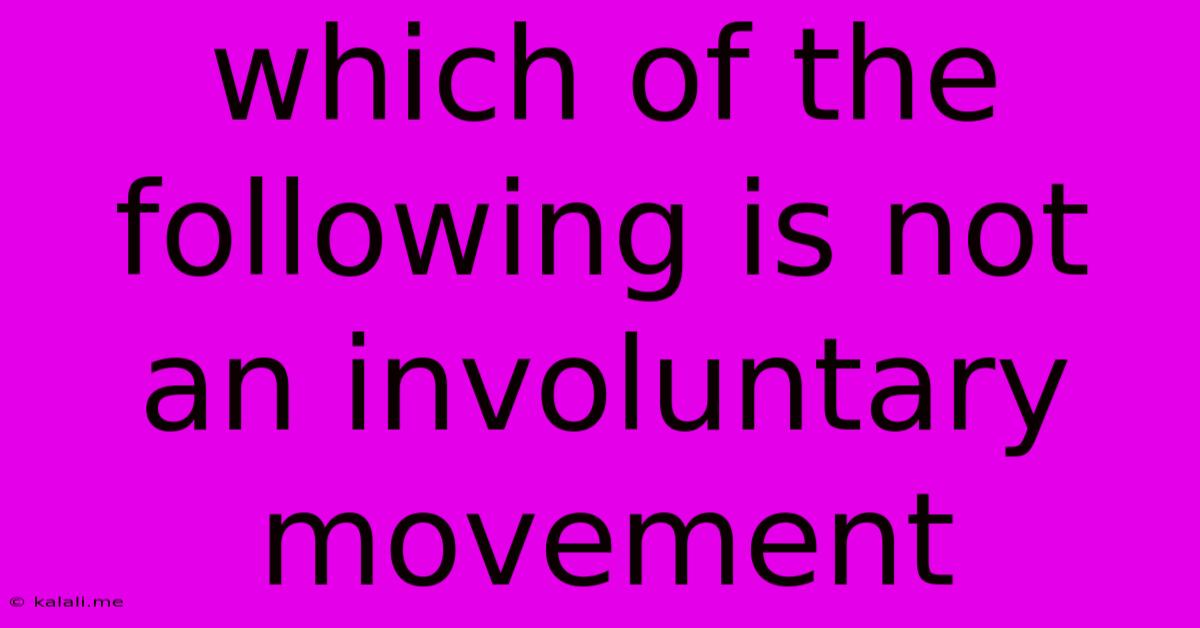Which Of The Following Is Not An Involuntary Movement
Kalali
Jun 15, 2025 · 2 min read

Table of Contents
Which of the Following is NOT an Involuntary Movement? Understanding Voluntary vs. Involuntary Actions
Our bodies are constantly in motion, a complex interplay of voluntary and involuntary actions. Understanding the difference is key to comprehending how our neurological systems function. This article will explore the distinction between voluntary and involuntary movements, helping you determine which actions fall into each category and ultimately answer the question: which of the following is NOT an involuntary movement?
What are Involuntary Movements?
Involuntary movements, also known as reflexes or autonomic movements, occur without conscious control. They are primarily governed by the autonomic nervous system and are crucial for essential bodily functions. Examples include:
- Breathing: The rhythmic inhalation and exhalation of air, essential for survival.
- Heartbeat: The continuous pumping of blood throughout the body, maintaining circulation.
- Digestion: The complex process of breaking down food, absorbing nutrients, and eliminating waste.
- Blinking: A protective reflex that keeps the eyes lubricated and shielded from debris.
- Sneezing: A forceful expulsion of air from the lungs, clearing irritants from the nasal passages.
- Shivering: An involuntary muscle contraction to generate heat and maintain body temperature.
What are Voluntary Movements?
Voluntary movements, on the other hand, are consciously controlled actions initiated by the somatic nervous system. These actions involve deliberate thought and intention. Examples of voluntary movements include:
- Walking: A complex coordinated movement involving multiple muscle groups.
- Talking: Articulating words and sounds requires precise muscle control.
- Writing: The intricate movements required for forming letters and words.
- Playing a musical instrument: This demands fine motor control and coordination.
- Lifting weights: A conscious exertion of muscular force.
- Reaching for an object: A deliberate action directed towards a specific goal.
Identifying the Non-Involuntary Movement: A Case Study
Let's consider a hypothetical multiple-choice question:
Which of the following is NOT an involuntary movement?
A. Heart beating B. Digestion C. Playing the piano D. Blinking
The correct answer is C. Playing the piano. Playing the piano requires conscious thought, deliberate finger movements, and coordination. It is a voluntary action, controlled by the somatic nervous system. Options A, B, and D are all involuntary movements, governed by the autonomic nervous system.
Beyond the Basics: Understanding Neurological Complexity
While the distinction between voluntary and involuntary movements seems straightforward, the reality is far more nuanced. Many actions involve a complex interplay of both systems. For example, while walking is generally considered voluntary, maintaining balance involves involuntary adjustments and reflexes. Similarly, breathing can be consciously controlled to a certain extent, although it primarily operates involuntarily.
Understanding the intricacies of the nervous system and the interactions between voluntary and involuntary actions is an ongoing area of scientific research. However, recognizing the fundamental distinctions between these two types of movement provides a valuable foundation for appreciating the complexity and marvel of the human body.
Latest Posts
Latest Posts
-
A Ship Sails At 15 Miles Per Hour
Jun 15, 2025
-
Moment Of Inertia Of At Section
Jun 15, 2025
-
Capital Of Dadar And Nagar Haveli
Jun 15, 2025
-
Density Of A Unit Cell Formula
Jun 15, 2025
-
100 Aptitude Questions And Answers Pdf Download
Jun 15, 2025
Related Post
Thank you for visiting our website which covers about Which Of The Following Is Not An Involuntary Movement . We hope the information provided has been useful to you. Feel free to contact us if you have any questions or need further assistance. See you next time and don't miss to bookmark.